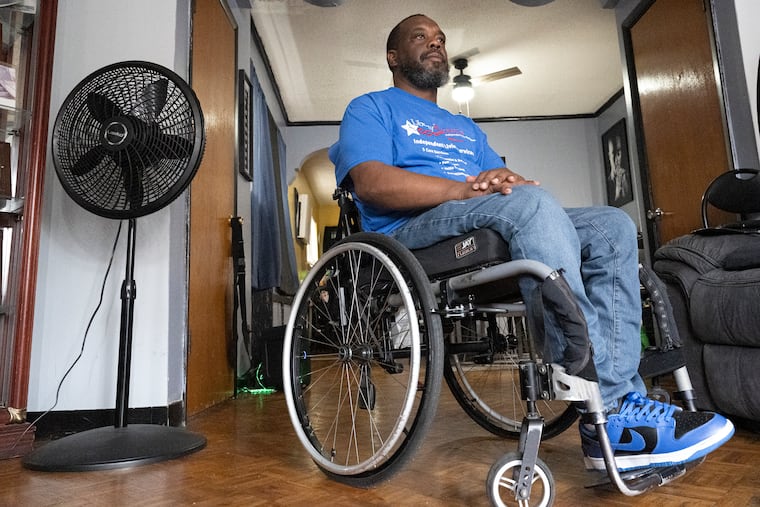Employment among Americans with disabilities soared during the pandemic. Can the trend survive the return to office?
As some employers move back to fully in-office employment, advocates hope that remote work’s boon to workers with disabilities won’t be forgotten.

Ever since Rodney Whitmore suffered a gunshot wound in 1995, he has needed assistance to get around. Since then he experiences firsthand the difficulties of navigating a world that isn’t designed with wheelchair users in mind.
One of the challenges is holding down a job, even one in an office. For someone living with a physical disability, the morning commute itself can be an insuperable challenge. A too-crowded bus or a broken elevator might be an annoyance for many commuters, but an impossibility for someone who needs help to get around.
Whitmore, who lives in South Philadelphia, works for Liberty Resources, an advocacy and services organization for people with disabilities, where he has long seen the people he works with struggle to find a place in the job market. But since the COVID-19 pandemic, and the attendant rise of remote work, he’s seen employment among the organization’s membership spike.
“Remote work from home, hybrid work from home, it gave them more a sense of hope,” said Whitmore. “It’s a change of attitude, a change of lifestyle. You got something to look forward to now, instead of just waiting for a monthly SSDI [Social Security Disability Insurance] check.”
Now, as some employers like Amazon and the City of Philadelphia move back to fully in-office employment, Whitmore and other advocates hope that remote work’s boon to workers with disabilities won’t be forgotten. (Historically, help from the Americans with Disabilities Act has been limited in this regard, because companies won court cases prior to the pandemic that found employers are not obligated to adopt accommodations like remote work.)
A new paper published by the National Bureau for Economic Research earlier this month shows that Whitmore’s observation is part of a national trend. Researchers from California and Sweden found a dramatic spike in employment among Americans with disabilities since 2019 that is not mirrored in any other demographic category of gender, race, age, or education.
In 2020, people without a disability had employment rates of almost 80%, while only 32% of those with a disability were employed. Pre-pandemic employment trends among the two groups echo each other, despite the vast gulf between them.
But after COVID, employment among those with disabilities rose by 12.4% while employment of people without disabilities remained constant.
The researchers find that this employment surge is largely correlated with the rise of remote work, and that the increase in employment among Americans with physical disabilities is mostly concentrated in occupations that enjoy high levels of work-from-home optionality.
“Around the pandemic, we’ve seen an enormous, quite unprecedented rise in employment of Americans reporting a disability,” said Nicholas Bloom, professor of economics at Stanford University and one of the authors of the study. “If you have hearing issues, vision issues, a bad back, or it’s really hard to walk, it’s potentially extremely difficult to commute and also a lot harder spend all day in an office.”
Bloom says this spike in employment is a sharp contrast to more standard recessionary periods, where people with disabilities often lag behind in employment.
“Working remotely, it really helps people with physical disabilities maintain employment,” said Whitmore, who notes that even if fully remote work isn’t an option, a hybrid schedule is easier for many people with disabilities than a full return to the office. Whitmore, for example, works two days in office and three days at home.
He notes that many of his clients live in apartment buildings with elevators that work imperfectly, which can cause them to miss in-office days. His own wheelchair lift malfunctions sometimes too.
“So by working from home I don’t have to worry about losing my job because I can’t get to work,” said Whitmore.
The pandemic era has made many employers more accepting of employees’ need to work from home sometimes, even when more in-office days are expected. But Bloom also argues that companies’ hybrid rules should apply universally, not just to workers with disabilities.
“The thing you don’t want if you have a disability is you’re at home five days a week, and everyone else is coming in,” said Bloom. “Because you [would] get totally cut off. It’s important that not only you get to work from home, but others are ideally on the same schedule, because then you’re completely connected.”
Bloom and his colleagues also point out that as the population of the United States ages, considerations for workers with disabilities will only become more relevant. Most people aren’t born with physical disabilities, but are more likely to have one as they age. Hybrid and remote work will allow more people to stay in the workforce longer.
“Most Americans with a disability tend to be older,” said Bloom. “So as time goes on, this effect is only going to grow. People who find it a bit harder to walk, to move, to lift stuff, rather than retiring can maybe stay and work part-time, partly from home, which I think is fantastic for society.”